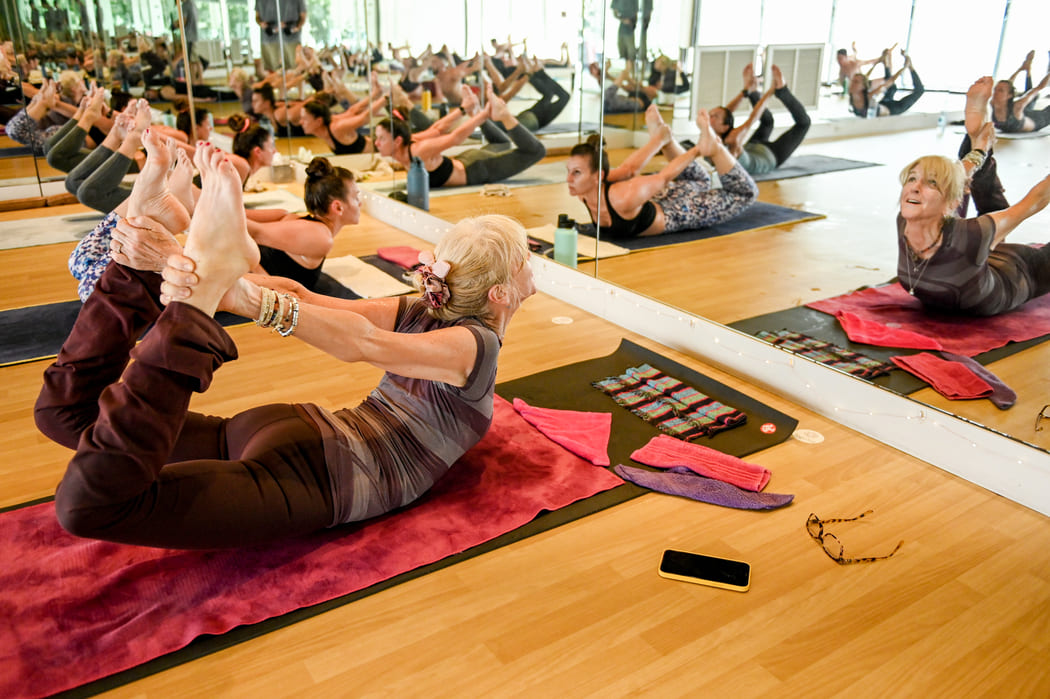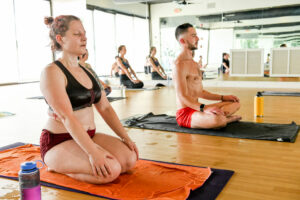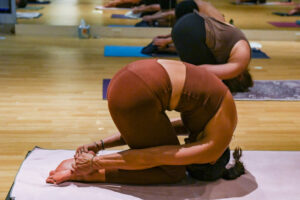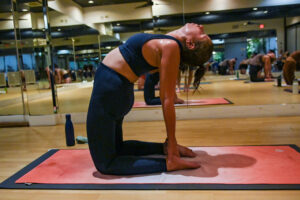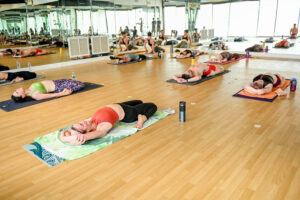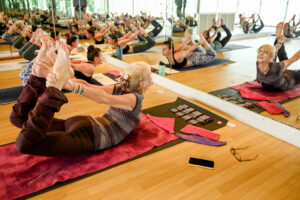Imagine yourself in the serenity of the “Half-Tortoise Pose” within a 105-degree Bikram Yoga studio. There you are sitting, in a 105-degree yoga studio filled with a dozen other yogis, but somehow, you feel like no one else is in the room with you. You’re in your own private little shell, cut off from the outside world, and all that remains is calm and peace.
Welcome to the tranquil world of Bikram Yoga, where each pose tells a story of balance, strength, and serenity. In this post, we’ll explore the Ardha Kurmasana (or Half-tortoise Pose). It’s a relaxing, introspective pose that creates ample opportunities for self-reflection, stabilization, and balance.
Let’s get started.
Before diving into the Half-tortoise pose, here is what we will cover in this article:
History of the Ardha Kurmasana Pose
Picture yourself in a Bikram Yoga studio, surrounded by the invigorating heat and energy. It’s in this radiant setting that the Half-tortoise pose, Ardha Kurmasana, finds its home.
The name ‘Ardha Kurmasana’ is derived from two Sanskrit words – ‘Ardha’ meaning ‘half’ and ‘Kurmasana’ signifying ‘tortoise pose.’ This position, much like an actual tortoise, drives you to withdraw and find solace within yourself.
In the entire cycle of Bikram Yoga poses, the Ardha Kurmasana stands out as a remarkable gem. It gracefully combines elements of forward bending, spine stretching, and deep relaxation. As you settle into this pose, you will experience a unique sense of surrender, both to the posture and to your inner self.
This pose can be traced back to the yogic traditions of Hatha Yoga, where it was incorporated to increase flexibility and release tension. The Ardha Kurmasana has seamlessly adapted to Bikram Yoga, offering practitioners a chance to explore their limits within the warmth of a hot yoga studio. Its journey through time has evolved into a beloved pose, resonating with yogis seeking balance and inner peace.
How to (Step by Step)
Here’s a step-by-step guide to achieving the serenity of the Ardha Kurmasana in your Bikram Yoga practice:
- Find a comfortable spot on your yoga mat, and kneel down with your buttocks resting on your heels. Ensure that your knees are together or slightly apart, depending on your comfort level. This initial posture establishes a strong foundation for the pose, allowing you to feel grounded and balanced.
- Inhale a deep breath. As you do, slowly raise your arms overhead, extending them towards the sky. Your palms should come together, fingers pointing upwards. This graceful upward motion aligns your body, creating a sense of length and openness.
- Exhale slowly and fold your torso forward at your hips. Keep your back straight, avoiding any rounding. This controlled forward movement allows you to maintain a straight spine, while you gracefully descend into the pose, inching closer to the floor.
- As you fold forward, bring your forehead gently to rest on the mat or floor in front of you. Ensure that your neck remains extended, creating a natural line from your tailbone to the crown of your head. This elongation safeguards your neck and spine.
- Your arms should remain extended in the direction of the stretch. The palms of your hands should stay connected, creating a straight line from your hands to your hips. This alignment allows you to engage your upper body and maintain balance throughout the pose.
- Activate your core muscles to support your spine in this forward bend. Breathing deeply and rhythmically is essential as you stretch through your spine. With each breath, you can sense your spine gradually elongating, deepening the stretch.
- Maintaining this pose, relax into it, and focus on your breath. Take your time to settle into the stretch and maintain it for a duration of 20-30 seconds. This pause allows your body to adapt to the pose and your mind to connect with your breath, fostering a sense of tranquility and surrender.
- As you complete your time in Ardha Kurmasana, inhale gently, and with care, begin the process of returning to a seated position. This return should mirror the grace of your initial descent, ensuring a smooth transition in and out of the pose. Each movement is a deliberate part of your yoga journey.
Benefits of the Half-tortoise Pose
The Ardha Kurmasana offers a plethora of physical and mental benefits to those who embrace it in their Bikram Yoga practice:
Spinal Flexibility
As you gracefully ease into the Half-tortoise pose, you’ll feel a subtle but powerful stretch sparking down your whole spine. The stretching sensation not only helps to elongate your spine, but it also encourages a more poised and graceful posture in your day-to-day life.
Stress Reduction
This pose is great for calming the mind and bringing you to a place of serenity. It gently cradles your nervous system, soothing away the ripples of stress and anxiety. Each breath taken in this pose becomes a whisper of calm, a respite from life’s frenetic pace. The nature of this pose lends itself to shutting out the stimuli of the environment around you, helping you concentrate on within.
Digestive Health
When you lean into the soothing embrace of the forward bend in this pose, your abdominal organs receive a luxurious massage. They awaken, stimulated and rejuvenated, setting the stage for optimal digestion. No more feeling weighed down; the Ardha Kurmasana clears the path to digestive vitality.
Improved Concentration
The allure of the Ardha Kurmasana lies not just in the physical realm, but in the profound mental clarity it imparts. As you practice this pose, your focus sharpens, like a lens finding its perfect clarity. It invites you to explore mindfulness, an essential tool in the modern world’s whirlwind of distractions.
Relaxation
In all of the hustle and bustle of your life, the Ardha Kurmasana can create a serene pause for you to gather your thoughts and feelings. Think of it like your own little sanctuary, a refuge from the chaos, where you are enveloped in a gentle, calming embrace.
Once you’ve fully transitioned into the Half-tortoise pose, stress will take a backseat, and peace will fill your mind. It’s one of the most calming sequences of the entire Bikram yoga cycle and is a refuge from life’s taxing demands.
Better Posture
The benefits of Ardha Kurmasana extend well beyond the yoga mat. With regular practice, this pose serves as your silent guardian, nurturing an upright posture that carries you through your daily life. Your body learns to stand tall and proud, aligned with grace and poise.
Ways You Can Modify the Half-Tortoise Pose
Just like any other Bikram Yoga pose, there are several modifications you can employ to give yourself an easier entry into the position, especially if you’re a beginner or have physical limitations.
Here are a couple of variations to consider:
- Use props to help with your positioning: If reaching the floor with your forehead is a challenge, place a yoga block or cushion under your head to support it comfortably.
- Use knee support: For those with sensitive knees, you can place a cushion or folded blanket between your heels and buttocks.
These modifications ensure that you can experience the benefits of the pose while respecting your body’s unique needs and limitations.
Last Thoughts on the Half-Tortoise Pose
Ardha Kurmasana, the Half-tortoise pose, is a treasure in the world of Bikram Yoga. Its roots in ancient yogic traditions have allowed it to evolve into a pose that promotes physical and mental well-being. As you practice this pose, you’ll not only nurture your body’s flexibility and strength but also discover the profound sense of tranquility it offers.
So, embrace this pose, breathe deeply, and let its calming influence guide you on your yogic journey. If you’re interested in following along through guided lessons, we cover all 26 poses in our studio. Remember, each time you enter this position, you’re not just bending forward; you’re also bending inward toward a more peaceful and more centered self.
FAQ
Q: Is the Half-tortoise pose difficult?
A: Every pose in Bikram yoga has its challenges. The convenient part about the Half-tortoise pose is that it’s generally simpler than most of the other poses. The hardest part for many tends to be finding a comfortable place of rest with your buttocks sitting on your heels, as the way you place your own body weight on your feet can sometimes cause pain. It just takes a little maneuvering to settle into a spot that’s comfortable for you.
Q: Will the heat in a Bikram yoga studio be too much for me to handle?
A: The heat in a Bikram yoga studio is intentionally set at a high temperature to facilitate deeper stretching and promote sweating, which can have detoxifying effects. While it can feel intense, it’s generally manageable for most people. However, it’s crucial to listen to your body. Stay well-hydrated, take breaks when needed, and don’t push yourself beyond your limits. If you have any medical conditions or concerns, it’s advisable to consult with a healthcare professional before starting hot yoga. Over time, your body can acclimate to the heat, and many people find it enhances their yoga practice.
Q: What if I can’t calm myself mentally to fully embrace the pose?
A: Part of the whole purpose of yoga is to help escort your mind to a place of mental refuge. Even if you can’t find yourself getting there right when you’d want to, that’s where committing to the motion of finding and holding the designated pose can be a great help in training your brain to let go of whatever distractions or stressors are going on that are preventing you from relaxing.
 -ing our NEW! Community Classes!
-ing our NEW! Community Classes!
